How to Grow Raspberries – Planting, Care and Harvest
This post may contain affiliate links. Read my full disclosure here.
We share what you need know to grow raspberries, from planting to harvest, plus the difference between Summer Bearing and Fall Bearing Raspberries.
Raspberries provide delicious sweet tart fruit for fresh eating, cooking and preserves such as jams and jelly. With the right plants, you can have fruit the first year.
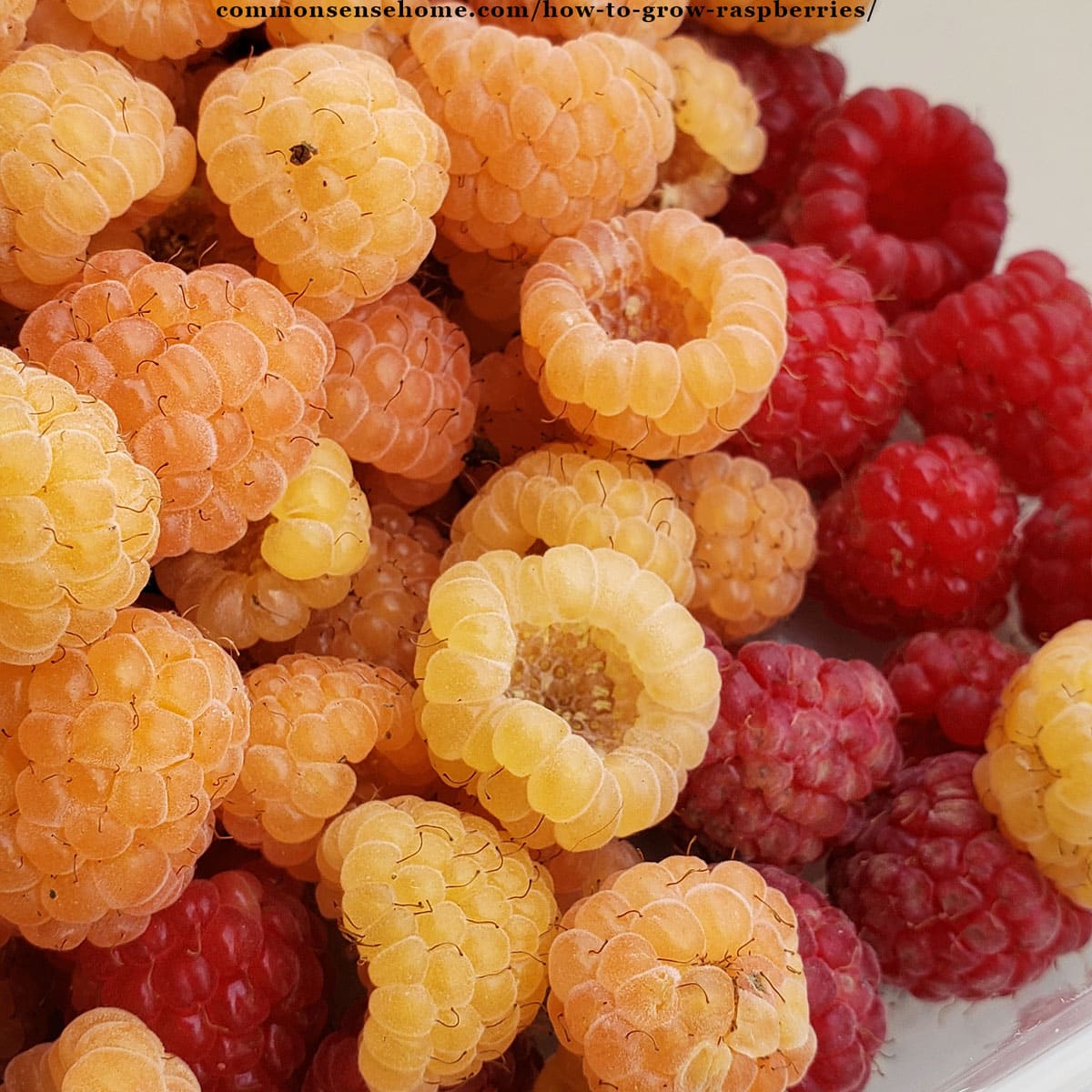
How to Grow Raspberries – The Basics
- Raspberries grow in USDA hardiness zones 4 through 8.
- They prefer rich, well drained soil with pH between 6.0 and 6.8 and full sun.
- Do not plant raspberries where nightshade family plants, strawberries, or wild raspberries were grown in the last 3 years, as those plants can harbor diseases that damage raspberries.
- Space different varieties of raspberries 100 feet apart.
- Plant raspberries in spring. Space new raspberry bushes about 2 feet apart within a row and plant rows about 4-6 feet apart. The plants will produce side shoots to fill in the row.
- Install wire supports for tall varieties to keep the raspberry canes upright in rows.
- Use several inches of organic mulch to reduce weeds.
- Raspberries need around an inch of water per week during the growing season.
- Fertilize raspberries early in spring for maximum growth. Avoid fertilizing after August 1st.
- Remove dead or damaged canes in early spring.
- Pick ripe raspberries every few days to avoid spoilage.

Two Types of Raspberry Plants – Summer Bearing and Fall Bearing
There are 2 categories of raspberries, summer bearing and fall bearing. The difference between the two types is due to the fruiting cycles.
Summer bearing raspberries bear fruit in one large crop between early July and August.
Fall bearing raspberries (sometimes called Ever Bearing raspberries) produce a large fall crop and a smaller crop the next summer.
Raspberries have perennial roots and crowns, but the above ground canes only live two summers. The new growth (first year cane) is called the “primocane”.
On summer-bearing varieties, the primocane produces non-fruiting growth only. Fall bearing raspberries produce fruit on the tips of the primocanes sometime after August 1st, and keep producing until a killing frost.
In the second summer, the primocane that grew the last summer is now called a floricane.
The floricane (second year cane) of summer bearing varieties produces one large crop of berries and then dies. In fall bearing cultivars, the cane will set fruit on the lower half of the cane and then die.
Black, Red, Purple and Yellow Raspberries
Raspberries come in a rainbow of colors – from yellow to red to purple to black. Only the yellow and red are hardy in Zone 3 where I garden.
Plant different varieties of raspberries 100 feet apart to avoid cross pollination and disease transfer.
Raspberry Varieties We Recommend
I prefer to grow the fall bearing raspberry varieties for a couple of reasons.
The weather is cooler and rains come more often in the fall, so I don’t have to water as often. The only down side is that an early hard frost can cut the harvest short.
Because of how they bear fruit, I can prune them fast with a modified weed wacker. (See the explanation in the pruning section.)
Some of our favorite raspberries include:
- Red Everbearing best overall flavor
- Yellow Everbearing also known as “Fall Gold” – amazingly sweet
How long do raspberries take to grow?
As noted above, if you grow fall bearing raspberries, you may get fruit the first fall they are planted.
Summer bearing raspberries won’t produce fruit until at least one year after planting.
Raspberry Growing Requirements – Soil and Location
Raspberries are perennial, and a well maintained raspberry patch can last for years. Choose your raspberry growing location wisely.
Where do raspberries grow?
Raspberries grow in USDA Plant Hardiness Zones 4 through 8.
Raspberries grow best in full sun on well drained soil rich in organic matter. They prefer soil pH between 6.0 to 6.8.
In a pinch, they can tolerate pH as low as 5.5 and as high as 7.5.
Ideally, it’s best to prepare the soil a year before planting. Test the soil and amend it with organic matter such as worm castings, compost, or rotten manure. Adjust the soil with lime if the pH is 5.5 or below.
Avoid Planting Areas that may Harbor Diseases
When selecting a site, avoid garden spots where tomatoes, potatoes, eggplant, or strawberries where planted in the last 3 years. Those plants share many of the same diseases as raspberries and could infect your patch.
Try to avoid growing raspberries within 600 feet of wild raspberries.
You may be wondering, “Why not simply grow wild raspberries?” Wild raspberries are much less productive than cultivated varieties.
Wild raspberries can also harbor diseases and insects that will harm your berries. They can cross pollinate with tame berries, reducing your crop.
What’s the best time to plant raspberry bushes?
Spring is the best time to plant raspberries, especially if you’re starting with bare root plants.
That said, it’s okay to plant potted raspberries in fall or early summer, too. Avoid planting in extreme heat, as that will stress the plants.
Raspberry Plant Spacing
Space new raspberry bushes about 2 feet apart within a row and plant rows about 4-6 feet apart.
Each year, new canes grow up from the roots. Over time, your plants will spread over a wide area.
Would you like to save this?
Supports for Growing Raspberries
Given our short growing season and the sturdy growth in my raspberry patch, I don’t trellis my canes.
If you’re in a longer season area with tall, floppy plants, check out this article on Training and Trellising Raspberries.
How do you take care of raspberry bushes?
Your berry patch must have water. If you get a period without rain, you need to supplement with a watering program, or the blossoms will dry up and end your harvest in as little as 10 days.
Cultivate a Clear Border
Cultivate or mulch heavily around the outside of your patch to keep rhizome grasses like quack at bay.
If you mow nearby grass short, it will make your maintenance much easier.
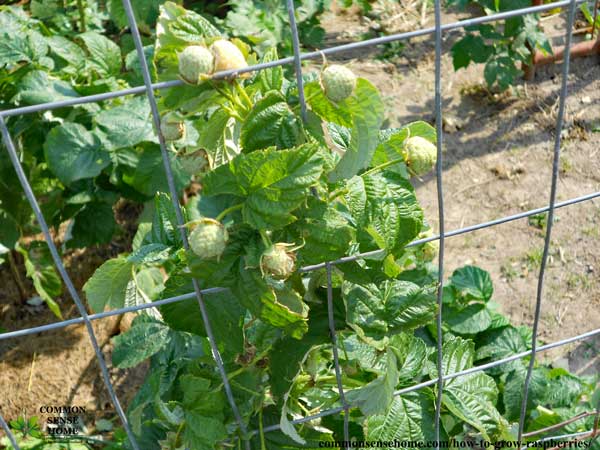
When to Prune Raspberries
In early spring, remove dead canes and burn them or move them far from your patch. This is the best way to keep your plants pest free, as some insects will overwinter in the dead canes.
Removing the dead canes also removes diseased plants, giving new growth a better chance. Dead canes must be removed each year if you want to have a healthy planting.
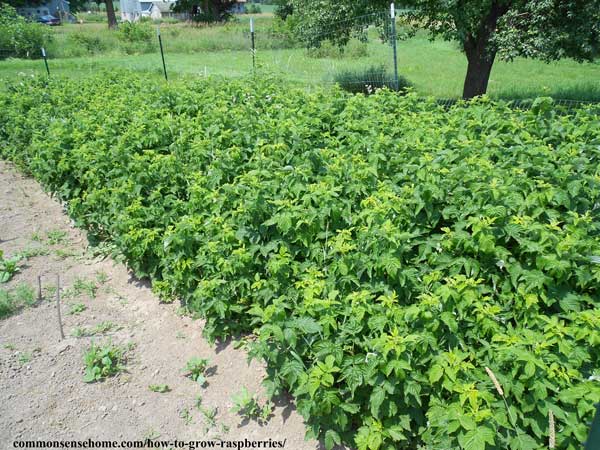
Fast Pruning Option for Fall Bearing Raspberries
With fall bearing varieties, you can cut the entire patch to the ground with a SHARP tool after the harvest.
I use a weed wacker blade attachment to avoid damaging the crowns, which is quicker and easier than pruning individual canes.
I cut the canes back in the fall after they die back 100%. If I don’t get to them in fall, I cut them down early in the spring before they bud out.
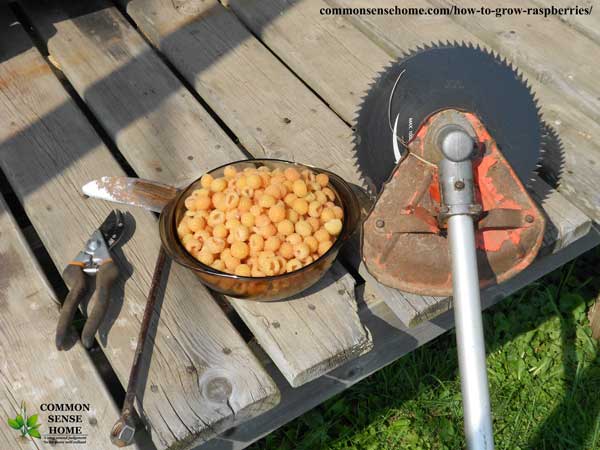
When to Fertilize Raspberries
You should fertilize your raspberry patch early in the spring for maximum growth.
Avoid fertilizing after August 1st so you don’t encourage new growth late in the season. Late season growth makes plants susceptible to winter damage.
Established plants need nitrogen for new cane growth. Top dress the canes with composted manure or compost, and consider an organic granular fertilizer.
Mulching Your Raspberry Patch
A 2 inch layer of mulch is very beneficial for growing raspberries.
Use old silage, leaves, lawn clippings, wood chips, sawdust, wood shavings, or rye or sudan grass straw are free of weeds. All of them will help keep in moisture and add to the soils nutrients as they break down over time.
If you use sawdust mulch, add extra nitrogen. Because of the small particle size of the sawdust, it steals nitrogen from the soil as it breaks down.
If you want to maintain paths between rows, multiple layers of cardboard under the mulch will slow down the raspberry runners.
Pests and Diseases
Most raspberry pollination (90%) is done by bees, so using any insecticide is a bad idea.
Destroy dead and sick canes, pick fruit promptly, and fertilize regularly, and pest problems should be minimal. I’ve never had a serious problem in my patch.
See “Insect Pests of Raspberry Fruit” and “Common Pests and Diseases” for more information.

Harvesting and Storing Raspberries
Ideally, raspberries should be picked into shallow containers because they crush and bruise easily. In dry weather they will be more durable.
Raspberries normally store a few days in the refrigerator, except under wet or very humid conditions, which will cause them to mold quickly.
Do not wash them before storage, or they will become soft and mushy. If your patch is clean, you don’t need to wash your berries before use.
You need to pick at least twice a week to avoid fruit spoilage.
For nutritional information and storage tips, please visit Raspberry Storage and Health Benefits of Raspberries. We also have a low sugar raspberry jam recipe here.
I can only speak for myself, but homemade raspberry jam is my favorite. It tastes nothing like the product you buy in the store – the raspberry flavor is much stronger.
I hope you enjoyed this information on how to grow raspberries, and that you’ll consider growing your own home raspberry patch.
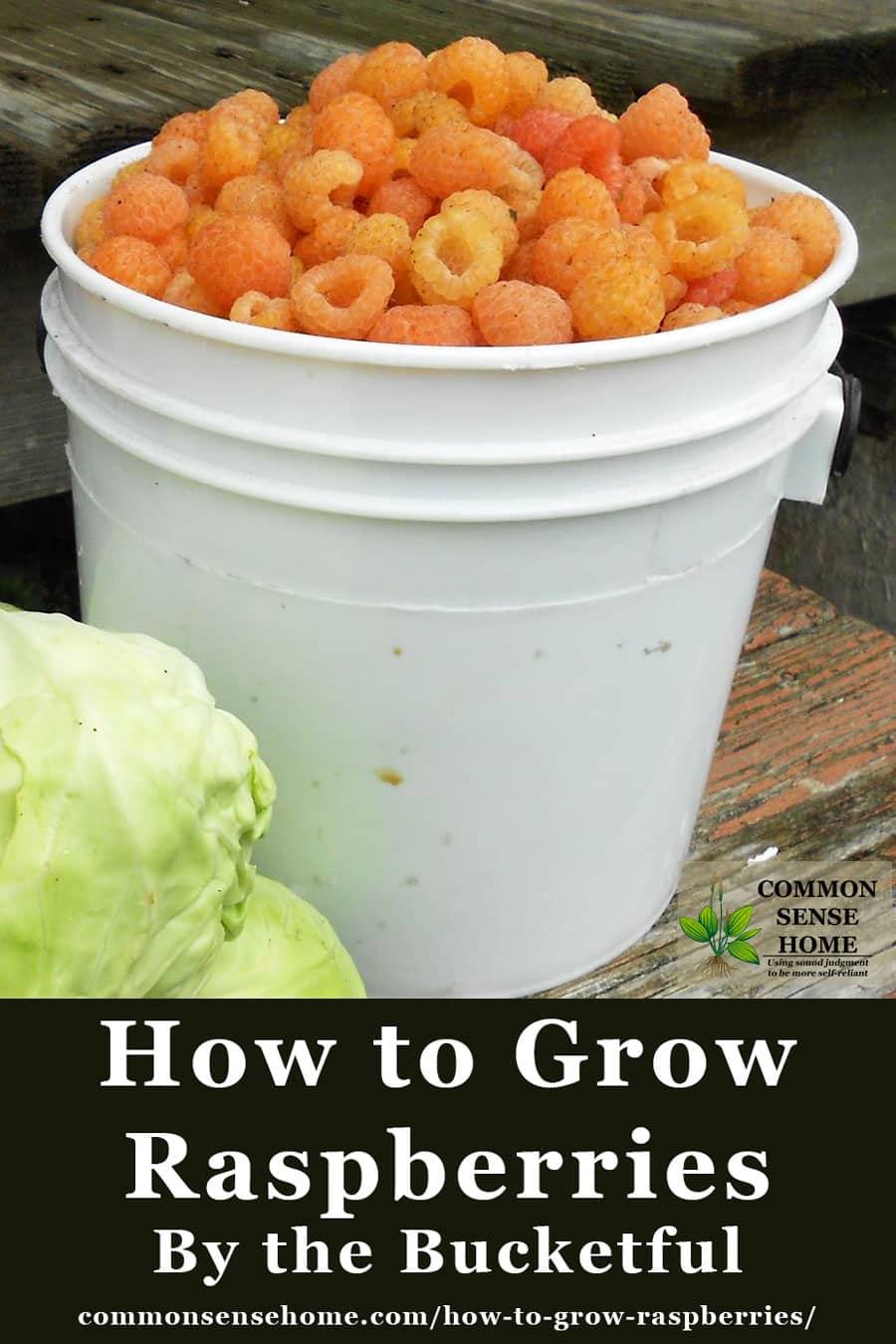
This post includes raspberry growing information from the USDA Cooperative Extension Service. Cooperative Extension is a great source for local gardening information.

This post is by Laurie Neverman’s brother, Richard Poplawski. Since his service in the Marines, Rich has been a mechanic, fabricator and “fix just about anything” guy for over 20 years. He lives in northwest Wisconsin and maintains a large orchard and perennial plantings, as well as a vegetable garden. He loves spending time with his grandkids, introducing them to gardening or getting in some fishing with “Papa Rich”.
Related Posts
See a full list of all our gardening articles on the Common Sense Gardening page.
Originally published 2013, last updated March 2020





I just made your raspberry cream pie for my husband. His mom made a similar pie and I have been looking for a similar recipe for a long time. Most raspberry cream pie recipes are entirely different. He loved this pie and I can’t wait to make it again when local raspberries are available.
I’m glad you enjoyed it.
Should you plant raspberries vertically or horizontally on a east facing slope?
I’d probably run the rows north to south.
I am looking for advice for preventing anthracnose disease in my red raspberry patch. I keep my plant row thinned for air circulation, but have had problems ever since liquid-lime sulfur, used as a dormant spray, was made unavailable to home gardeners. last summer I found a partial bottle of the liquid-lime sulfur in my garage and used that and my raspberries were rejuvenated. What can I use this spring? I had previously tried some liquid copper sulfate in spring, followed later by sulfur spray, without a lot of success, and it required much more frequent sprayings. I’m getting up in years and want to simplify things. Any suggestions? I’d hate to give up my patch.
Amazon appears to have various types of liquid lime sulfur available. Bonsai Jack or Soil Sul – If that worked previously you may consider ordering it. We are not familiar with liquid lime sulfur.
Thanks for the suggestion, August, but these won’t work for my problem.
Maybe TeraGaniX EM-1 – 16 oz – All Natural Organic Microbial Inoculant? Or aerated compost tea to dose the leaf surfaces with good microbes to crowd out the bad microbes?
Hi there—we bought a home which to our surprise, had some established although neglected raspberry plants. This past spring I cut out the dead and added fertilizer. Now we have a ton of green growth and are getting some berries but is there a secret to increasing berry yields? Location of plants is almost full sun (all day) Does yield depend more on the variety planted? I’ve been been to raspberry farms and those bushes are FUll with berries!!
Thank you!
Yield absolutely depends on the variety planted. If you have lush green growth and little fruit, you may well have inherited a wild raspberry patch. It sounds like you’ve cared for them correctly to have good berry production – plenty of sun, pruning and a little fertilizer. I use my wild raspberries mainly for their leaves, as they yield very little fruit.
Are there neighbors nearby who might remember if the patch was ever productive? Years back, we had a red raspberry patch that we wanted to expand. A neighbor gave us some raspberry canes. It turns out, they were wild raspberries. They introduced a disease that pretty much wiped out the original plants, and took over the patch. Lesson learned – no unknown raspberry plants allowed in the patch. We had to start from scratch in a different location. Our yellow raspberries and black raspberries were almost completely wiped out, too.
Thank you for your response! I really appreciate it 🙂
Good luck!
I am pretty much brand new to gardening. We just moved to Oklahoma and I would like to plant some raspberries. I was thinking I could just go to the local nursery to plant some already established plants. Do I need to pretreat the soil? And if so, what do I pretreat it with?
Raspberry Growing Requirements – Soil and Location
Choose Slightly Acid Soil
Being a perennial, a well maintained raspberry patch can last for years. Raspberries grow best in full sun on well drained soil rich in organic matter. They like a slightly acid soil with a pH 6.0 to 6.8, but can tolerate a pH as low as 5.5 and as high as 7.5. Ideally, the soil should be tilled a year ahead, soil tested, and amended with organic matter such as worm castings, compost, or rotten manure and lime if the pH is 5.5 or below.
I Live in the upper midwest and have a beautiful raspberry patch. The problem I have is in the past 3 years when the raspberries are ripening I find that they have been attacked by the spotted winged drosophilia. Because I don’t want to use a spray on my berries and I’m trying to stop the cycle, I have cut all of my producing stocks and burn them. Obviously this is not working very well for stopping the problem. Do you know what can be done? My family loves raspberries, but having maggots in the berries is simply disgusting. I realize these will not harm you, but I find it appalling.
I wonder if establishing more habitat for the predators of the drosophilia would help? An organic blueberry producer encourages queen anne’s lace in his blueberry plantings, because it acts as a host plant for the wasps that parasitize the drosophilia. He said it’s taken care of their maggot problem. There’s more info in the queen anne’s lace post at https://commonsensehome.com/queen-annes-lace/.
At the age of 86, I am new at this since the real gardener moved on to heaven. The plants, well established by now, looked rather hungry so I purchased some bags of manure with a plan to spread it around my small patch. Now I am concerned about killing the plants with it. May I spread the manure right next to the plants without doing damage? I should have paid more attention.
Sorry for the loss of the real gardener. Sounds like you had many wonderful years together. If it’s composted manure (which the stuff in the bags is), then you should be just fine. Only hot (fresh) manure is likely to damage the plants.
Just found this site, as a newbie I just planted 10 plants as a experment.
thanks
Good luck. Don’t forget mulch and some food for the plants.
I just planted a couple of Heritage (everbearing) bare root raspberry plants last weekend, and it seems like it would be a good idea to put some mulch down to try and control weeds as well as provide some cover for the soil for when it gets hotter in the summer. I’ve got a bunch of pine needles in my yard so I was thinking of using those as mulch. When should I put down mulch? Should I wait a while to get more growth going before I put any mulch down? Any advice would be appreciated.
Thanks!
Go ahead and mulch them right away. It’ll keep the soil from drying out, slow down weed growth and offer protection for the young plants.
Very useful information. I have some problems in my raspberry farms. The tip of the new growths turn black and the leaves are curly. Do you know what should i do about this? They caused us a great loss of harvest. And we have lots of aphids on the berries too. Please tell us what to do. I want to grow them as organic as possible.
Thanks for your help
Sayu
Sounds like a possible viral issue and general poor health of plants, making them susceptible to pests and disease. Try more compost/rotted manure as a top dressing, and compost tea or fish fertilizer for foliar feeding.
Without a doubt, one of the better raspberry growing articles I’ve seen.
Thanks, Daryle.
I’m planting about 60 plants this year, half being the summer and half the fall variety.
i’ve been reading everything I find about raspberries and found this article very informative and easy to
understand even for dummies like myself.
Loved reading this, as well as all of your articles, always save everything and keep coming back.
Thank you for sharing your tips and knowledge!!
Glad that you enjoyed the post, Bianca, and good luck with your raspberries.
We have summer bearing raspberries, but they try and fruit again in mid October. Do you know why they do this and how to prevent it??? We are in zone 6a.
It sounds like you may not have “summer only” bearing raspberries.
I have the everbearing variety. When do you cut them down to the ground? We didn’t cut them at the end of last season, so I have very tall canes right now. Is it too late to cut them down? They already have some new buds on them.
I cut them in the fall after they die back 100%, or if I don’t get to them I cut them early in the spring before they bud out. Since yours are budding out already, clear cutting them now may set them back. You could try pruning out the dead canes and putting up supports for the rest to keep them upright.
If you prune them it will set them back, it takes a lot for a plant to come out of the dormant stage and start growing. It will not kill them, they will just be behind for the year. You didn’t say where you are located. I’m in Zone 3 and plan to cut mine this week because I didn’t get them last fall. Hope this helps. It’s pretty hard to kill them as long as you don’t damage the crown of the plant.
I’m reading this on an iPad and there are little icons for sharing that cover up the text in the left side. Literally Covers the text I am meant to be reading. Why is that? Is it on purpose? Are those letters unimportant to the article?
The little icons are share icons, to make the post easier to share on social media, which generates much of the traffic to the site. Given the wide variety of devices that people use to access the site, unfortunately the display doesn’t always line up perfectly. To get rid of the icon boxes, there’s a little set of blue double arrows that should show up just beneath them if you touch there on the screen. Hit the double arrows and the share boxes disappear.
We have discovered black raspberries growing beside a very old home on our property. They produce fairly well although small. We’ve not tended to the plants to this point. The old home never had running water but had a great cistern. We thought possibly they were planted close to house because of the nearby water source.
After reading the article it seems there is a wild variety. Can you tell how to differentiate between wild and domestic varieties?
Great article by the way!
There’s no real straightforward way to determine what’s wild and what’s not, since botanically they are pretty much the same. Domesticated varieties have just been selected to produce larger fruit and more abundant harvests. Heirloom varieties often produce smaller fruit than modern cultivars, so it could simply be an older variety. With TLC, you may be able to improve yields, no matter what type it is, and if it’s survived without care, you know it’s tough.
I live in St Petersburg FL. Do you have any knowledge to share of growing raspberries in my area? If so when is a good planting time and harvest?
This article might help, “How to Grow Blackberries and Raspberries in Florida“.
Does it take a few years for a plan to produce fruit? This will be my 3rd season with my plants- I didn’t get anything the 1st or 2nd year. Do you know if this is normal? Or maybe I’m doing something terribly wrong….
And here’s another (dumb!) beginner’s question: How do I know if mine are “summer bearing” or “fall bearing”??
Thank you for your help! Great article!
AnneMarie
It’s been awhile since my patch was new, but I’m pretty sure I had a small harvest one year after planting, and then the patch grew and spread and the harvest increased.
do you know what type of plants you have? Most are labeled summer bearing or fall bearing. If you don’t know what type they are, you need for them to produce fruit so you can tell if they produce more in summer or fall. Summer bearers produce a heavy crop in June, then peter out. Fall bearers produce some earlier, but their main crop is in fall.
If you still don’t have any signs of fruit after three years, I’d be a little concerned that either something is lacking in your site/soil, or you’ve got a variety that’s non-productive. We got some free canes from a neighbor when we wanted to expand our patch. They introduced disease (to which they were immune) and killed off the rest of the patch. (The patch in the photos is my brother’s.) Those “free” canes cost us our raspberry patch, and they never produced more than a couple of tiny berries.
Wow! very helpful site! I am glad I found it
Welcome, Jessi.
Very nice article! I love raspberries and have had limited success growing them. The only thing I would add is to consult your local Cooperative Extension service (US) before planting. I live in NE OK (US) and raspberries will most likely burn up in full sun no matter what soil or how well you water. I lost mine in 2011 and switched to blackberries. If you check the PLANTS database, you will see they don’t want to grow in the SE US at all.
Yes, it’s definitely good to check whether it’s possible to grow something in your area before you get your heart set on growing it. Check here to find a cooperative extension office near you.
Thank you!! The information is greatly appreciated. Looking at my newly planted canes under a couple inches of snow in April in Chicago. Look forward to reading more.
We’ve got snow here, too, with more expected. I’ll be so grateful when spring arrives to stay!
I live in the New England state of NH and have several raspberry bushes close to several blueberry bushes. The blueberries did not grow and the one lovely raspberry I managed to eat was all there was. I don’t know why this year is different from other years other than he extreme heat. I enjoyed reading your comments and hints and am going to do,some research on my own. I love reading everything that you all post. I am a farm, prairie lady at heart and enjoy your ideas and comments.
Thank you for your kind words.
Have you ever done a soil test? That may be a place to start. Also, good thick mulch is very good for soil building, keeping down weeds, preserving moisture and protecting the roots of the plant from temperature extremes.
Thank you for posting this. I have just planted an Heirloom variety and hope it will bear well like yours.
I have summer bearing I believe. They are red and they are everywhere slowing taking over my garden. I want to move them somewhere else but I’m not sure how to do that or when. Is this advisable? I always remove the dead canes in the Spring here in western NY and would love to move the whole patch so I have more room in my veggie garden. Thanks for any help!
There’s a great Q & A on raspberries at http://www.ext.nodak.edu/extnews/hortiscope/fruitveg/rspberry.htm. They cover moving raspberries and various raspberry scenarios.
How many plants should I plant for a family of 6? I am new to fruit crops and can’t seem to find the answer to my question anywhere.,
Becca – production and consumption vary greatly from family to family, but Colorado State University Extension says that, “Twenty-five feet of row should produce 15 to 20 pounds of raspberries per year.”
Love your web-site and facebook page! So I started vegetable gardening 3 years ago, and am fairly new to this. That said my raspberry patch is only on it’s second year, and was looking quite nice until about a week ago when I noticed some skeletonized leaves. Apparently I have a sawfly infestation. There is no way I can handpick them all off. I’ve tried and am not getting anywhere! I’ve read about Spinosad which is an organic pesticide, but it carries a “low possibility of honey bee death.” There are hives on the property next to mine, and I purchase my honey from a local apiary so I don’t think this is an option. Is there any advice you can give me on how to deal with this? Also, if I can’t control them how will the fruit be impacted? Thank you so much!
Handpicking and insecticides seem to be the two recommendations I’m finding.
http://www.ipm.ucdavis.edu/PMG/GARDEN/FRUIT/PESTS/raspsawfly.html
“Handpick and destroy infested leaves. The raspberry sawfly does not generally warrant further control unless plants are threatened with defoliation.”
Give your plants some extra TLC. Anything you can do to strengthen the plant/improve the soil will lessen damage and improve recovery time. Unhealthy plants invite insects and disease. I have seen this in my own garden. Top dress with some compost or rotten manure, foliar feed with compost tea, weed tea or fish emulsion. Add mulch to reduce swings in soil moisture and temperature.
Thank you for the advice. I have plenty of fish emulsion so I’ll feed them today. I did add lots of compost to the soil before planting the canes, but I’ve never “top dressed” them so I’ll try that this weekend.
Thanks for all the time and advice you share with us!
You’re very welcome.
If you’re curious, you may want to check out Building Soils Naturally and Working with Nature: Shifting Paradigms. Both focus on innovative methods of building soil health to promote plant health. Both books were written by people from Gaia College, and they really got me thinking.
Thanks so much. I’m a horticulturist and love learning more about anything botanical! I have three different types of rassers. This information helped a ton!! Ps. Loved your coffee cake recipe!!
Thanks, Deb.
One thing about plants – there is always more to learn, even when you have been growing for years.
You can research saw fly predators and then plant the flowers that will attract them. A simple ground cover of allysum could be extremely beneficial
Great information. Thanks for the article. Can black raspberries be planted near the red varieties? I read recently (and can’t remember where) that they should be separated by at least 150 feet.
Rick
Ideally it is best not to plant them close to each other, because reds may harbor disease without showing signs of disease, but can still transmit the disease to the blacks.
From the University of Illinois Extension:
“Red raspberries tend not to show virus symptoms if infected but aphids can still spread the virus to Black raspberries that tend to be very susceptible. Plant black raspberries away from red raspberries but if you have a limited space, always plant black raspberries upwind from the red raspberries so that aphids are not blown by wind from red to black raspberries.”
The North Carolina Cooperative Extension states:
“All raspberries are self-fertile and may be planted alone. Plants of red and black raspberries should be separated by 700 ft.”
Thanks. 700 feet is a long way to have to keep them separated. Families with close neighbors would need to keep this in mind.